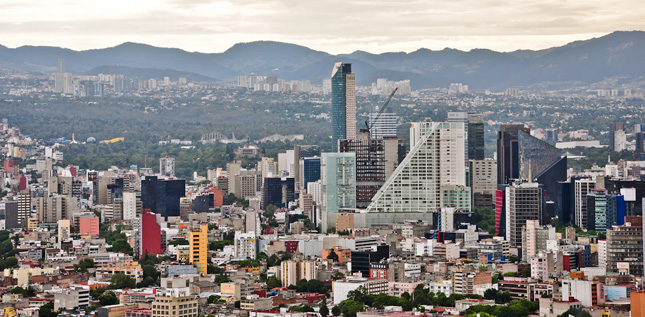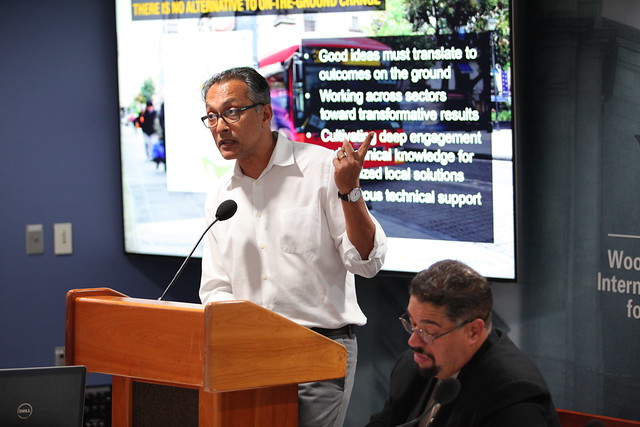-
Cities After Paris: The Role of Subnational Actors in Achieving International Goals
October 17, 2017 By Julianne Liebenguth
As the climate changes, cities will suffer. “These are important places that have a lot of people, property, and local economies that are going to struggle,” said Jessica Grannis, the adaptation program manager at Georgetown’s Climate Center, at a recent Wilson Center event on the role of subnational decision-makers in achieving international goals. “The good news is that, here in the United States, many cities are recognizing these threats to their people and populations, and they’re beginning to take action,” said Grannis.
Building a Resilient City
Through innovative action plans and cross-sector initiatives, cities can protect their communities from environmental changes that threaten their local economic and political infrastructure. City governments can take the initiative by “using things like their zoning powers and their taxing powers to be able to implement responses that will make their communities more resilient,” said Grannis. Local-level decision-makers have the political leverage to instill adaptive planning and protect communities from coastal flooding, increased rainfall, drought, and wildfires.
Broadcast live streaming video on UstreamBut the capacity for local-level governments to innovate and respond to climate risks varies dramatically across regions. Many cities in the global South, for example, struggle to provide the public resources needed to limit their vulnerability to climate change. Aniruddha Dasgupta, who works with urban areas in developing countries at the WRI Ross Center for Sustainable Cities, pointed to the rich cities of the world—New York, Copenhagen, Singapore—and explained that “the capabilities they have to provide services compared to cities we work in is actually [a] quantum difference.” The question then, said Dasgupta, is “how will these cities succeed?”
Desgupta’s research suggests that if developing cities focus their limited resources on transportation, land use planning, and energy systems, they can significantly improve their citizens’ quality of life and productivity while also reducing emissions. “These few strategies—that allow cities to actually impact these three different dimensions of climate, quality of life, and competiveness— [are] the kind of strategies we want cities to focus on.”
Transcending Borders: Sister Cities and Citizen Diplomacy
“Citizens have the right, if not responsibility, to participate in international affairs”City partnerships and citizen diplomacy can serve to advance the overarching objectives of international goals, such as the Paris Climate Agreement and the Sustainable Development Goals, by building peace and fostering agency among a wider range of actors.
Through network building, cities—and even citizens themselves—are in a position to promote peace and accelerate the implementation of innovative ideas on an international scale. “[C]itizens have the right, if not responsibility, to participate in international affairs,” said Adam Kaplan, vice president of Sister Cities International, a nonprofit organization that advocates for knowledge exchanges across cities.
Sister Cities supports innovation by tapping into outside networks, said Kaplan, because “some of the most valuable information [and] the most innovative information that we can find is not going to be from our friends and close networks. It’s going to be from the extended networks.”
Sister Cities International “allows cities and local groups to tap into networks that are totally separate from the usual groups they interact with.” Sister Cities maximizes the value of the networks it builds by clustering, which Kaplan defined as building connections between cities that share similar industries, such as pairing port cities with port cities.
To fully capture the social aspect of innovative cooperation, Sister Cities International encourages “open-ended” partnerships that last longer than the duration of grant-based projects. “We think of these relationships as between cities, but they are relationships between people,” said Kaplan.
Challenges for Cities after Paris
“Cities are at the mercy of what other nations do on the mitigation question”Although cities are taking proactive steps toward authenticating the goals set during the 21st Conference of the Parties (COP-21), subnational actors still face considerable barriers. “Cities are at the mercy of what other nations do on the mitigation question,” said Grannis; countries’ “action or inaction on mitigation and reducing greenhouse gases is going to affect how expensive it is going to be to adapt.”
Resilience planning within cities is still largely dependent on the broader implementation of the Intended Nationally Determined Contributions established at COP-21. “[Cities] are really going to be the ones that primarily suffer if we as a society and nation-states aren’t able to meet those goals,” said Grannis.
Lack of funding can also prevent city leaders from learning from and engaging with each other. According to Kaplan, limited resources for international travel among city-level decision makers can impact their degree of “cross-cultural competency.” Sister Cities International encourages a more global approach to allocating financial resources and advocates for “more federal, state, and local funding for municipal personnel focused on the international sphere—and a lot more political consensus on the need to engage internationally.”
Despite these challenges, city leadership has become central to the global discourse on climate change and resilience. “People thought only nation-states can solve big problems in the world,” said Dasgupta. “That has really changed.” We should continue building cities “that work for businesses, work for climate, [and] work for people,” he said.
Event Resources:
Sources: Georgetown’s Climate Center, Sister Cities International, World Resources Institute Ross Center for Sustainable Cities
Photo Credit: View of the Mexico City skyline from Torre Latinoamericana, June 2010, courtesy of Flickr user Storkholm Photography
 A Publication of the Stimson Center.
A Publication of the Stimson Center.




